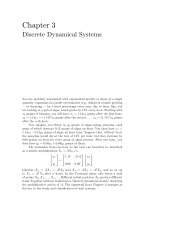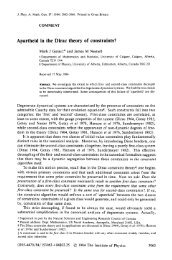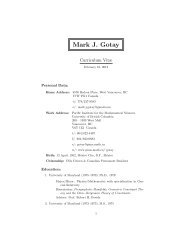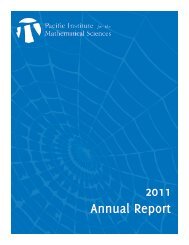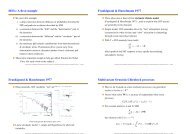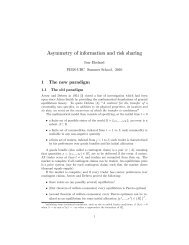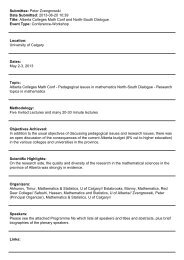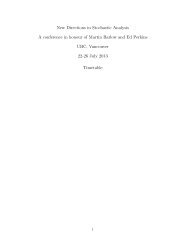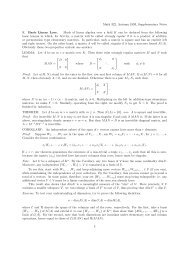25 PRIMA 2013 AbstractsPedram Hekm<strong>at</strong>iUniversity of Adelaide, Australiapedram.hekm<strong>at</strong>i@adelaide.edu.auT-duality is a discrete symmetry in string theory th<strong>at</strong> rel<strong>at</strong>estopologically distinct torus fibr<strong>at</strong>ions and provides adictionary for transl<strong>at</strong>ing geometrical structures betweenthem. The duality is m<strong>at</strong>hem<strong>at</strong>ically well-understood intype II theories and the purpose of this talk is to explainhow it can be extended to the heterotic setting.The setup n<strong>at</strong>urally involves string structures and reductionof Courant algebroids. This is joint work with DavidBaraglia.A motivic approach to Potts modelsM<strong>at</strong>ilde MarcolliCalifornia Institute of Technology, USAm<strong>at</strong>ilde@caltech.eduThe use of motivic techniques in Quantum Field Theoryhas been widely explored in the past ten years, in rel<strong>at</strong>ionto the occurrence of periods in the comput<strong>at</strong>ion ofFeynman integrals. In this lecture, based on joint workwith Aluffi, I will show how some of these techniques canbe extended to a motivic analysis of the partition functionof Potts models in st<strong>at</strong>istical mechanics. An estim<strong>at</strong>eof the complexity of the locus of zeros of the partitionfunction, can be obtained in terms of the classesin the Grothendieck ring of the affine algebraic varietiesdefined by the vanishing of the multivari<strong>at</strong>e Tutte polynomial,based on a deletion-contraction formula for theGrothendieck classes.The Wess-Zumino-Witten model on SL (2; R)David RidoutThe Australian N<strong>at</strong>ional University, Australiadavid.ridout@anu.edu.auThe prototypical examples of string theories on targetspaces with non-trivial topologies are the Wess-Zumino-Witten (WZW) models for which the target is a compactreductive Lie group. However, the non-compact case isphysically more relevant and is m<strong>at</strong>hem<strong>at</strong>ically richer aswell. While the pioneering work of Maldacena and Ooguriproposed string spectra and proved a no-ghost theoremfor the WZW model on SL (2; R), recent work has shownth<strong>at</strong> the underlying conformal field theory is far richer, <strong>at</strong>least for certain levels, and provides an example of a socalledlogarithmic conformal field theory. This talk willreview this recent work and wh<strong>at</strong> it suggests for othertheories with non-compact target spaces.M-branes and higher bundlesHisham S<strong>at</strong>iUniversity of Pittsburgh, USAhs<strong>at</strong>i@pitt.eduWe describe the M-branes in M-theory via higher geometry,including String structures, String bundles with connections,higher (stacky) notions of Chern-Simons theory,and rel<strong>at</strong>ion to higher WZW models. This is joint workwith Domenico Fiorenza and Urs Schreiber.T-duality for circle bundles via noncommut<strong>at</strong>ivegeometryM<strong>at</strong>hai VargheseThe University of Adelaide, Australiavarghese@adelaide.edu.auIt is known th<strong>at</strong> topological T-duality can be extendedto apply not only to principal circle bundles, but also tonon-principal circle bundles. We show th<strong>at</strong> this resultcan also be recovered via the noncommut<strong>at</strong>ive geometryapproach which we previously used for principal torusbundles. This work has several interesting byproducts,including a study of the K-theory of crossed products byÕ(2) = Isom(R), the universal cover of O(2), and some interestingfacts about equivariant K-theory for Z/2. Theseresults are then extended to the case of bundles withsingular fibers, or in other words, non-free O(2)-actions.This is joint work with Jon<strong>at</strong>han Rosenberg.Special Session 13Measurable and Topological DynamicsHeight reducing problemShigeki AkiyamaUniversity of Tsukuba, Japana.h.dooley@b<strong>at</strong>h.ac.ukWe say th<strong>at</strong> an algebraic number α has height reducingproperty (HRP) if there is a positive integer B th<strong>at</strong>Z[α] = B[α], i.e., every number in Z[α] has an equivalentrepresent<strong>at</strong>ion with coefficients in {−B, . . . , B}. Thisproblem is studied for algebraic integers, since it has intim<strong>at</strong>econnection to the construction of self-affine tilings.In this talk, we consider HRP for general algebraic numbersand obtain some ‘almost’ if and only if conditionfor HRP. The proof relies on a quantit<strong>at</strong>ive version ofKronecker’s approxim<strong>at</strong>ion theorem. This is a joint workwith Toufik Zaimi.Large devi<strong>at</strong>ion principle for chaotic dynamicalsystemsYong Moo ChungHiroshima University, Japanchung@am<strong>at</strong>h.hiroshima-u.ac.jpWe will discuss a class of chaotic dynamical systems forwhich the full large devi<strong>at</strong>ion principle holds. It containsintermittent maps and quadr<strong>at</strong>ic maps on intervals,almost Anosov diffeomorphisms on tori and countableMarkov shifts with return time functions of ’gentle’slopes.Chaotic dynamics of continuous-time topologicalsemiflow on Polish spaceXiongping DaiNanjing University, Chinaxpdai@nju.edu.cnDifferently from Li-Yorke and others in liter<strong>at</strong>ure, we willintroduce the concept—chaos—for a continuous semiflowf : R + × X → X on a Polish space X without isol<strong>at</strong>edpoints, which is useful for the theory of ODE and is invariantunder topological equivalence. Our definition isweaker than Devaney’s since here f may have neitherfixed nor periodic elements; but it still implies the sensitivedependence on initial d<strong>at</strong>a similar to Devaney’schaos. We will show th<strong>at</strong> f always has a maximal chaoticsubsystem. In addition, we will consider the chaotic behavioron minimal center of <strong>at</strong>traction of a motion.Random dynamical systemsAnthony DooleyUniversity of B<strong>at</strong>h, UKa.h.dooley@b<strong>at</strong>h.ac.uk
26 PRIMA 2013 AbstractsIn joint work with Guo-Hua Zhang, we have extendedthe notion of random dynamical system from Z actionsto actions of discrete amenable groups.In this setting, we introduce local fiber topological pressureand establish a vari<strong>at</strong>ional principle rel<strong>at</strong>ed tomeasure-theoretic entropy.One can then define both topological and measuretheoreticentropy tuples, and apply the vari<strong>at</strong>ional principleto obtain a rel<strong>at</strong>ionship between them. These resultsrecover and extend many recent results in local entropytheory.Local entropy dimension for a measure and avari<strong>at</strong>ional principleDou DouNanjing University, Chinadoum<strong>at</strong>h@163.comThe notion of entropy dimension measures the subexponentialcomplexity of entropy zero dynamical systems.By considering topological entropy via hausdorff dimensionand measure-theoretical local entropy, we introduceBowen’s type entropy dimension D B (T, K) and local(lower) entropy dimension D locµ (T ) in entropy zerosystems. When restrict to a compact subset K, weprove the following vari<strong>at</strong>ional principle: D B (T, K) =sup{D locµ (T ) : µ ∈ M(X), µ(K) = 1}.Decomposition problems in symbolic dynamicsUijin JungAjou University, Koreauijin@ajou.ac.krA code is a homomorphism between shift dynamical systems.Problems concerning decompositions of one codeinto a composition of several codes were considered insymbolic dynamics for coding purpose. Although a lot isknown about the decompositions of factor codes betweensubshifts with equal entropy, not much is known for thecase of unequal entropies. The first part of the talk willbe devoted to the history and known results on the decompositionproblems. For the remaining part, our recentdevelopments will be presented. Especially we focus onthe set of possible entropies of intermedi<strong>at</strong>e subshifts arisingfrom decomposing a given code. This is a joint workwith Soonjo Hong and In-Je Lee.Overlap and strong coincidences on substitutiontilingsJeong-Yup LeeKwandong University, Koreajylee@kd.ac.krPisot number is an algebraic integer whose all the otherGalois conjug<strong>at</strong>es are less than 1 in absolute. Substitutionsequences can be constructed replacing a letter by aword from a given finite letters. Incidence m<strong>at</strong>rix is definedby the numbers of letters coming from each letter.If the largest eigenvalue of this m<strong>at</strong>rix is a Pisot number,we say th<strong>at</strong> the substitution is “Pisot”. We constructa tiling space collecting all the locally indistinguishabletiling from the given Pisot substitution tiling.It has been conjectured th<strong>at</strong> the tiling space of a Pisotsubstitution tiling whose substitution m<strong>at</strong>rix is irreduciblehas discrete dynamical spectrum. This is called“Pisot substitution conjecture” which has not been solvedfor many years. Many notions of coincidences in substitutiontilings have been introduced in the study of thediscrete dynamical spectrum of the tiling spaces.Here we consider two well-known coincidences in the area,namely overlap coincidence and strong coincidence, whoserel<strong>at</strong>ions are not completely understood. We establishone direction of the implic<strong>at</strong>ion from overlap coincidenceto strong coincidence.Subword complexity and Sturmian coloringsof treesSeonhee LimSeoul N<strong>at</strong>ional University, Koreaslim@snu.ac.krIn this talk, we introduce subword complexity of coloringsof regular trees. We characterize colorings of boundedsubword complexity and then introduce Sturmian colorings,which are colorings of minimal unbounded subwordcomplexity.We classify Sturmian colorings using their type sets. Weshow th<strong>at</strong> any Sturmian coloring is a lifting of a coloringon a quotient graph of the tree which is a geodesic or a ray,with loops possibly <strong>at</strong>tached, thus a lifting of an "infinteword". We further give a complete characteriz<strong>at</strong>ion ofthe quotient graph for eventually periodic ones. We willprovide several examples. This is a joint work with DongHan Kim.Shadowing properties with average tracing ofpseudo-orbits.Piotr OprochaAGH University of Science and Technology, Polandoprocha@agh.edu.plAverage shadowing properties generalize standard definitionsof shadowing (e.g. shadowing property, limit shadowingproperty, etc.) by controlling average error of tracinginstead of its control in each iter<strong>at</strong>ion. Clearly, thedefinition of pseudo-orbit have to be modified accordingly.This modific<strong>at</strong>ion enables applic<strong>at</strong>ion of average shadowingin dynamical systems where we cannot control errorin each step, but we can ensure th<strong>at</strong> average error is sufficientlysmall. In particular, there are maps with averageshadowing property but without shadowing property(and vice-versa).In this talk we will survey recent results on average shadowingproperties. We will present a few sufficient conditionsth<strong>at</strong> ensure average shadowing and comment onrel<strong>at</strong>ions between average shadowing and notions fromtopological dynamics, like shadowing property, mixing,specific<strong>at</strong>ion, proximality and the like.Higher order Bohr problem and rel<strong>at</strong>ed topicsSong ShaoUniversity of Science and Technology of China, Chinasongshao@ustc.edu.cnIn this talk we will discuss higher order Bohr problem andrel<strong>at</strong>ed questions. An old problem about Bohr sets saysth<strong>at</strong> for any syndetic set S, is the set S − S a Bohr 0 set?We study the higher order version of this problem: forany d does the common difference of arithmetic progressionwith length d + 1 appeared in a syndetic set coincidewith a Nil d Bohr 0 set? We show th<strong>at</strong> one side of thisquestion holds: for any Nil d Bohr 0 -set A, there exists asyndetic set S such th<strong>at</strong> A contains the common differenceof arithmetic progression with length d + 1 appearedin S. And we show th<strong>at</strong> other side of the problem can bededuced from some result by Bergelson-Host-Kra if moduloa set with zero density. This is a joint work with W.Huang and X.D. Ye.Neg<strong>at</strong>ivity of Lyapunov exponents in genericrandom dynamical systems of complex polynomialsHiroki SumiOsaka University, Japansumi@m<strong>at</strong>h.sci.osaka-u.ac.jpIn this talk, we consider random dynamical systems ofcomplex polynomial maps on the Riemann sphere Ĉ. It
- Page 2 and 3:
1PRIMA 2013-Table of ContentsTable
- Page 4 and 5:
3PRIMA 2013-OrganizationOrganizatio
- Page 6 and 7:
5PRIMA 2013-OrganizationYoshikazu G
- Page 8 and 9:
7PRIMA 2013-Useful InformationUsefu
- Page 10 and 11:
9PRIMA 2013-Useful InformationTaxi:
- Page 12 and 13:
11PRIMA 2013-Useful Informationmath
- Page 14 and 15:
13PRIMA 2013 Program-Schedule-at-a-
- Page 16 and 17:
15PRIMA 2013 Program-Monday, June 2
- Page 18 and 19:
17PRIMA 2013 Program-Monday, June 2
- Page 20 and 21:
19PRIMA 2013 Program-Monday, June 2
- Page 22 and 23: 21PRIMA 2013 Program-Monday, June 2
- Page 24 and 25: 23PRIMA 2013 Program-Tuesday, June
- Page 26 and 27: 25PRIMA 2013 Program-Tuesday, June
- Page 29 and 30: 28PRIMA 2013 Program-Tuesday, June
- Page 31 and 32: 30PRIMA 2013 Program-Tuesday, June
- Page 33 and 34: 32PRIMA 2013 Program-Wednesday, Jun
- Page 35 and 36: 34PRIMA 2013 Program- Thursday, Jun
- Page 37 and 38: 36PRIMA 2013 Program- Thursday, Jun
- Page 39 and 40: 38PRIMA 2013 Program- Thursday, Jun
- Page 41 and 42: 40PRIMA 2013 Program- Thursday, Jun
- Page 43 and 44: 42PRIMA 2013 Program- Friday, June
- Page 45 and 46: 44PRIMA 2013 Program- Friday, June
- Page 48 and 49: 1 PRIMA 2013 AbstractsContents1 Pub
- Page 50 and 51: 3 PRIMA 2013 Abstractsof subfactors
- Page 52 and 53: 5 PRIMA 2013 AbstractsprocessesXu S
- Page 54 and 55: 7 PRIMA 2013 AbstractsIn this talk
- Page 56 and 57: 9 PRIMA 2013 Abstractsindependently
- Page 58 and 59: 11 PRIMA 2013 AbstractsEnumerating,
- Page 60 and 61: 13 PRIMA 2013 AbstractsRyuhei Uehar
- Page 62 and 63: 15 PRIMA 2013 AbstractsIn this talk
- Page 64 and 65: 17 PRIMA 2013 AbstractsSpecial Sess
- Page 66 and 67: 19 PRIMA 2013 Abstractscritical slo
- Page 68 and 69: 21 PRIMA 2013 AbstractsSpecial Sess
- Page 70 and 71: 23 PRIMA 2013 Abstractsstrictly awa
- Page 74 and 75: 27 PRIMA 2013 Abstractsis well-know
- Page 76 and 77: 29 PRIMA 2013 Abstractssolid substr
- Page 78 and 79: 31 PRIMA 2013 AbstractsRapoport-Zin
- Page 80 and 81: 33 PRIMA 2013 Abstractssense. Our a
- Page 82 and 83: 35 PRIMA 2013 AbstractsIn an econom
- Page 84 and 85: 37 PRIMA 2013 AbstractsKyoto Univer
- Page 86 and 87: 39 PRIMA 2013 AbstractsAlexander Mo
- Page 88 and 89: 41 PRIMA 2013 AbstractsOsamu SaekiK
- Page 90 and 91: 43 PRIMA 2013 Abstractsopen Delzant
- Page 92 and 93: 45 PRIMA 2013 AbstractsJian ZhouTsi
- Page 94 and 95: 47 PRIMA 2013 AbstractsJiaqun WeiNa
- Page 96 and 97: 49 PRIMA 2013 Abstractsthe end of 2
- Page 98 and 99: 51 PRIMA 2013 AbstractsJongyook Par
- Page 100 and 101: 53 PRIMA 2013 AbstractsPancyclicity
- Page 102 and 103: 55 PRIMA 2013 AbstractsEfficient nu
- Page 104 and 105: 57 PRIMA 2013 Abstractsand fountain
- Page 106: 59 PRIMA 2013 Abstractsformula esti



